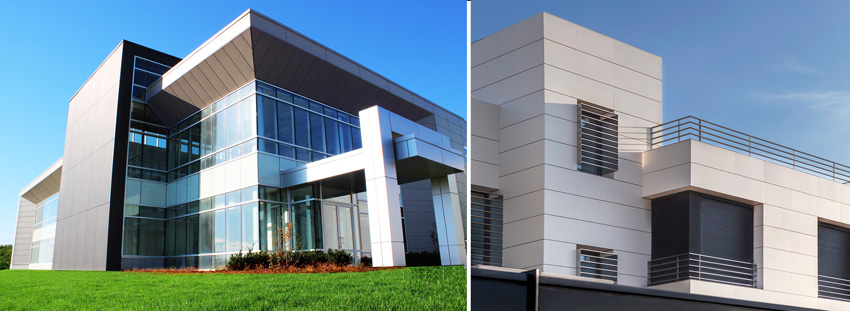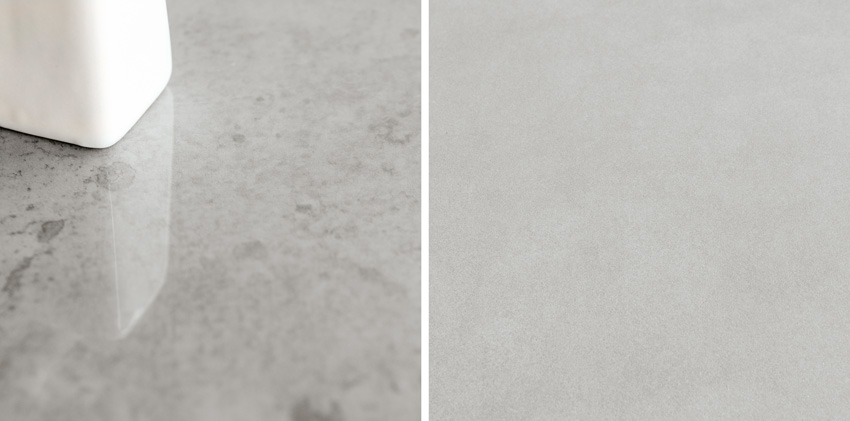Sintered Compact Surfaces For Building Facades
GREEN BUILDING CONTRIBUTIONS OF SINTERED COMPACT SURFACES
Any product used in building construction is usually scrutinized for its ability to contribute to green building design. Sintered compact surfaces have been looked at in this regard with favorable reviews.
In terms of materials and resources considerations, you will recall that sintered compact surfaces are 100 percent natural. Made of minerals, clays, feldspar, silica, and natural mineral pigments, sinter compact surfaces will not emit toxic fumes into the environment when exposed to fire or extremely high temperatures. It is also 100 percent recyclable since its natural composition allows the panels to be reduced to its aggregates and fully recycled. In fact, it is common to find that up to 52 percent of sintered compact surfaces are made up of recycled natural content.

Compact sintered panels can contribute to green and sustainable building design in terms of natural materials that don’t compromise indoor environmental quality.
Indoor environmental quality is enhanced when using sintered compact surfaces as a finish material. With a porosity of less than 0.08 percent, sinter compact surfaces are impervious to absorption and therefore do not contribute to problems associated with water penetration, such as mold, mildew, or other issues. This low porosity also makes it a hygienic material that is resistant to bacteria growth that can cause disease and trigger allergies. From a finishing standpoint, the lack of any paintings or coatings being needed means that none of the potentially harmful effects of volatile organic compounds (VOCs) often found in those paintings or coatings are eliminated. Overall, it is both environmentally neutral in terms of the effects on people and preventive in terms of what it helps avoid.
SPECIFYING SINTERED COMPACT SURFACE FACADES
When specifying sintered compact surfaces, there are of course numerous choices and specification details to pay attention to. Coordination with manufacturers during the design phases of a project will help gain insight into details, cost drivers, installation requirements, and finish options. Some of the relevant items to address in a standard three-part specification format are highlighted as follows.
Part 1: General
The scope of specification work can include all preparation work, substrate review, product choices, and final installation. In determining quality control for the products, and depending on the type of system being used, the following standards can be referenced:
- ASTM E283: Rate of Air Leakage through Exterior Windows, Curtain Walls, and Doors under Specified Pressure Difference across the Specimen
- ASTM E330: Structural Performance of Exterior Windows, Curtain Walls, and Doors by Uniform Static Air Pressure Difference
- ASTM E331: Water Penetration of Exterior Windows, Curtain Walls, and Doors by Uniform Static Air Pressure Difference
- ASTM C373: Water Absorption, Bulk Density, Apparent Porosity, and Apparent Specific Gravity of Fired Whiteware Products
- ASTM E119: Fire Tests of Building Construction and Materials
- ASTM C510: Staining and Color Change of Joint Sealant
- ASTM C794: Adhesion-in-Peel of Elastomeric Joint Sealants
- ASTM D412: Vulcanized Rubber and Thermoplastic Elastomers-Tension
- AAMA 508: Voluntary Pressure Equalized Rain Screen System Test
- NFPA 285: National Fire Protection Association
- CAN/ULC S134: Multi-Storey Fire Test
Submittals for sintered compact surface products should include the usual manufacturer’s data and information, plus any recommended maintenance and cleaning information to be passed on to the building owner/operators.
Quality assurance is clearly an important part of any field installed system, and the same is true here. Protecting products and materials at the site is always important, particularly if panels are improperly supported or stored.
Part 2: Products
All of the relevant products used in the building should be called out and specified, whether for interior or exterior applications. Each sintered compact surface product and the mounting systems should be identified by type in the specifications and shown on the drawings. The details of the specified products can include:
- Specific color and texture or pattern. Manufacturer’s literature should be consulted for this as with any finish product. Custom finishes are possible with some manufacturers depending on the quantity needed.
- Shade variation tolerance on color.
- Breaking strength as measured using standard tests.
In addition, the particular finishing details of the product should be specified for each type of product used. Hence, if any fabrication details are needed at the production plant, they should be clearly identified and specified for the particular product.

Specifying sintered compact surfaces includes selecting the type of finish on the surface, such as glossy (shown on left) or satin (shown on right).
Part 3: Execution
As with any finish product, the installation requires multiple steps, which need to be clearly articulated in the specification in order to receive the best results.
- Examination and Preparation: The importance of this work should be stressed. In addition to the architect, the installer should review and examine the substrate for conditions affecting the performance of the sintered compact surfaces. Any issues will need to be corrected if they are found to be out of compliance with the requirements of the specifications. Ultimately, the goal is to provide a substrate surface that has been prepared to an acceptable level and able to minimize any out-of-plumb or out-of-level conditions.
- Attachment: The system for attaching and securing the sintered compact surfaces should be specified accordingly. Installation of that system may need to be based on manufacturer’s recommendations and instructions.
- Placement: The panels should be placed in the prepared areas according to the patterns and layouts shown on the drawings and in accordance with manufacturers’ instructions or recommendations.
- Protection: Once applied, the sintered compact surfaces should not need any additional protection except as appropriate to keep unwanted construction activity away from it.
- Cleaning: As the panels are installed, they should be cleaned with a damp cloth to remove any dust or debris.
When specified and installed correctly, sintered compact surfaces can work quite well with other construction systems and help create the overall result intended.









